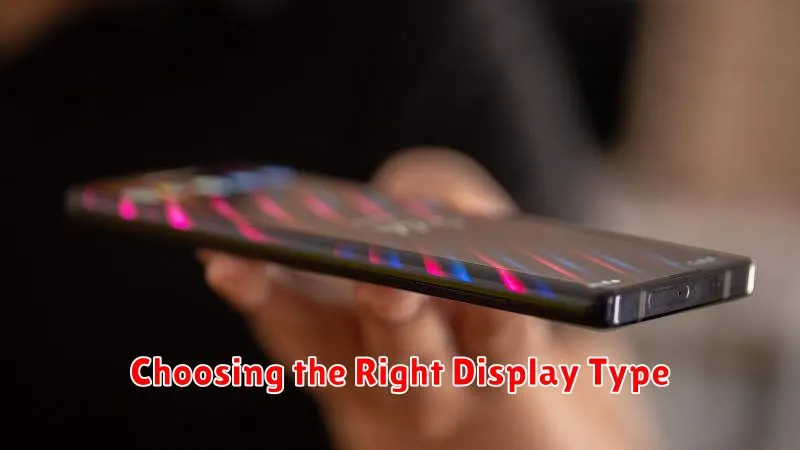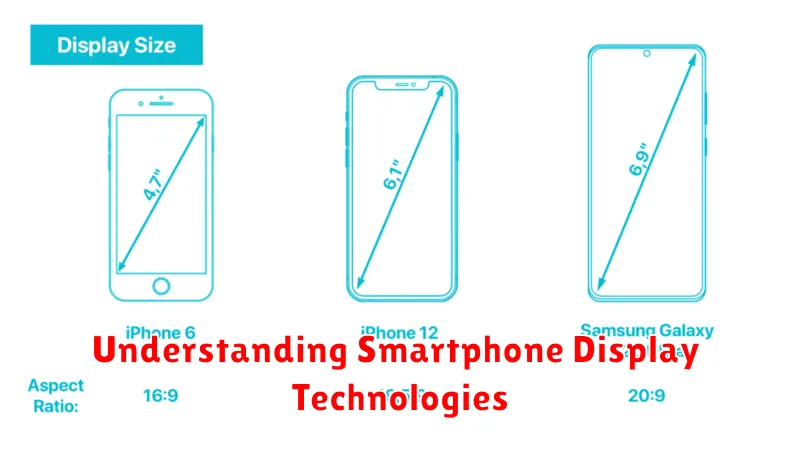In today’s digital age, smartphones have become indispensable tools, serving as our primary means of communication, information access, and entertainment. A crucial aspect of the smartphone experience is the display, the very window through which we interact with our devices. Understanding smartphone display technologies is paramount to making informed decisions when purchasing a new phone. This article delves into the intricacies of various display technologies, exploring the strengths and weaknesses of OLED, AMOLED, LCD, and other emerging technologies. We’ll examine key factors such as resolution, refresh rate, brightness, color accuracy, and power consumption to help you choose the perfect display for your needs.
From the vibrant colors of AMOLED to the power efficiency of LCD, the world of smartphone displays is constantly evolving. Whether you prioritize battery life, image quality, or affordability, this guide will equip you with the knowledge to navigate the diverse landscape of smartphone display technologies. We’ll dissect the technical jargon, explaining concepts like pixel density, contrast ratio, and HDR in a clear and concise manner. By the end of this article, you’ll have a comprehensive understanding of smartphone display technologies, empowering you to make an informed purchase decision and optimize your viewing experience.
LCD vs OLED Displays Explained
Liquid Crystal Displays (LCDs) and Organic Light-Emitting Diodes (OLEDs) are two dominant display technologies used in smartphones. They differ fundamentally in how they produce images.
LCDs rely on a backlight that shines through a layer of liquid crystals. These crystals can be manipulated to block or allow light to pass through, creating the image. Backlights are a key component, contributing to LCD thickness and power consumption. Different backlighting technologies like LED and fluorescent exist.
OLEDs, on the other hand, use organic compounds that emit light when an electric current is applied. Each pixel generates its own light, eliminating the need for a backlight. This allows for true blacks as pixels can be completely turned off, leading to superior contrast ratios and thinner displays.
| Feature | LCD | OLED |
|---|---|---|
| Black Levels | Dark Gray | True Black |
| Contrast Ratio | Lower | Higher |
| Power Consumption | Generally Higher | Generally Lower (especially with dark content) |
| Thickness | Thicker | Thinner |
Benefits of High Refresh Rates

A higher refresh rate translates to a more responsive and smoother user experience. The display refreshes more frequently, so animations appear more fluid and motion blur is reduced.
This is particularly noticeable when scrolling through web pages or social media feeds, where a higher refresh rate makes the experience feel significantly more natural. It also benefits gaming performance, enabling quicker reactions and a more immersive visual experience.
Reduced eye strain is another potential benefit. While not definitively proven in all cases, some users report less eye fatigue when using displays with higher refresh rates, particularly during extended periods of use.
Screen Resolution and Pixel Density
Screen resolution refers to the number of pixels that make up a display. It’s expressed as a grid of horizontal pixels by vertical pixels, such as 1920×1080 (Full HD) or 2560×1440 (Quad HD). Higher resolutions mean more pixels, resulting in sharper and more detailed images.
Pixel density, often measured in pixels per inch (PPI), indicates how tightly packed the pixels are on a display. A higher PPI generally leads to a crisper and smoother image, especially for text and fine details. PPI is calculated using the screen’s resolution and its diagonal size. A smaller display with the same resolution as a larger display will have a higher PPI.
The effect of resolution and pixel density is noticeable when comparing different displays. For example, a 5.5-inch display with a Full HD resolution will have a lower PPI than a 5.5-inch display with a Quad HD resolution. This difference translates to a visibly sharper image on the Quad HD display.
Impact on Battery Life
Display technology significantly impacts smartphone battery life. The display is often the largest power consumer in a modern smartphone. Therefore, understanding the relationship between display type and power consumption is crucial for maximizing usage time.
OLED screens offer potential power savings compared to LCDs, especially when displaying darker content. This is because each OLED pixel emits its own light, allowing for individual pixels to be turned off completely when displaying black. LCDs, on the other hand, rely on a backlight that illuminates all pixels, even black ones, resulting in higher power consumption for darker images.
Factors like screen brightness, resolution, and refresh rate also play a significant role. Higher brightness, resolution, and refresh rates generally lead to increased power consumption across all display technologies.
Choosing the Right Display Type

Selecting the right display for your smartphone depends on several factors, including budget, usage habits, and desired viewing experience. Understanding the strengths and weaknesses of each display type is crucial for making an informed decision.
OLED displays excel in producing vibrant colors, deep blacks, and high contrast ratios. They are also thinner and more power-efficient than LCDs, especially when displaying darker content. However, they can be more expensive and are susceptible to burn-in, although this is less of a concern with modern OLED panels.
LCDs, while generally less vibrant than OLEDs, are still a viable option, especially for budget-conscious consumers. They offer good color accuracy and brightness, and are less susceptible to burn-in. IPS LCDs, in particular, offer wider viewing angles than older LCD technologies.
Consider your priorities when choosing. If image quality and vibrant colors are paramount, OLED might be the better choice. If budget is a major concern, or if you prioritize longevity, LCD might be the preferred option.

